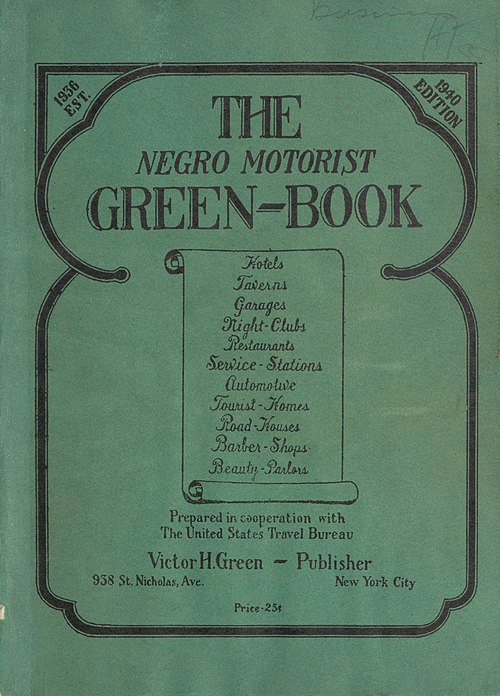
What was the Green Book? The Green Book was a list of places that would serve African Americans when they travelled around the USA between the 1930s and the 1960s. It was written by Victor Hugo Green, so he named it the Green Book after himself.
The full name of the book was “The Negro Motorist Green Book” and it was published every year between 1939 and 1966. It was started by an African American postal worker. It seems strange to think it now, but until 1964, racial segregation in the United States was not only legal, it was enforced by the police and the state. It was never called apartheid, but it was. It was more heavily used in the Southern States, but there was still segregation in the North. The slaves had been freed after the end of the American Civil War, but they were not “free”. They were not given the same rights as white people, and, in fact, in 1857, the US Supreme Court decided that African Americans could never be citizens of the United States. The 14th Amendment to the Constitution in 1866 gave them the right to be citizens, but segregation continued until 1965 and unofficially in some places until much later. The idea behind segregation was “separate but equal”. The white people thought that so long as the African Americans had access to the same facilities, it wouldn’t matter if they were segregated. This was just an attempt to ease their consciences. Inevitably, the facilities available to the non-white people were far worse than those reserved for white people.
Because of this segregation, it was incredibly difficult for people of color to travel throughout the United States. Many hotels, restaurants, and even restrooms were out of bounds to African Americans. That meant it was very difficult to find somewhere to stay. If an African American attempted to stay in a whites only area, at best they would be asked to leave, and at worst they would be arrested or physically harmed. At the same time as it became difficult to find places to stay across the US, it also became much easier for people to drive and to own cars. Cars began to increase rapidly in the 1920s and by the 1930s, when the first Green Book was published, African Americans could drive across country. By the end of World War 2, a lot of African Americans owned cars. This number was still significantly lower than the number of white people who owned cars, but it was increasing. That meant there was a market for a book that could tell people where they could stay.
The Green Book was created by a postman called Victor Hugo Green. He liked to travel when he wasn’t working and he realized how useful a guide of where to stay could be. He made his first Green Book in 1936 and he focused it on the area around New York, where he lived. The book was very popular and sales increased rapidly. In the subsequent editions, he began to look farther and farther afield until his book covered the whole of the United States. He was able to use all of his friends in the postal network to spread the book by word of mouth, but, more than that, it was an incredibly useful resource for African Americans. The book didn’t only cover places owned by African Americans, but all of the places that served African Americans. Some white establishments would serve African Americans, many would not.
The book had several purposes. The first was to give African Americans a travel guide that they could actually use. The second was to keep African Americans safe. They ran serious risk of physical harm if they were in the wrong areas, and the book aimed to keep them safe. The third purpose was to increase business for African American owned businesses. Not all of the places in the book were African American owned, but the majority were. And the fourth purpose was to get African Americans moving around the country. More people had cars, but there was a lot of fear about travelling to places that they didn’t know. This book would ease some of that fear and give people the confidence to move. Victor Hugo Green hoped that if more African American people travelled, it would normalize it and slowly decrease the amount of racism and then segregation in the US. He hoped that one day the book wouldn’t be necessary. He said, “There will be a day sometime in the near future when this guide will not have to be published. That is when we as a race will have equal rights and privileges in the United States.”
He published the book every year until his death in 1960. His wife continued to publish it for another 6years. In 1964, the Civil Rights Act was passed and segregation was made illegal. Green’s wife thought that there was no more need for the Green Book. It took a long time for segregation to actually end, and even today things are very hard for African American people. Still, they can legally travel wherever they want, stay in any establishment they want, and eat wherever they want. And this is what I learned today.
Try these next:
Sources
https://www.nps.gov/articles/000/the-green-book-an-historic-context.htm
https://www.pbs.org/wgbh/americanexperience/features/freedom-riders-jim-crow-laws
https://en.wikipedia.org/wiki/The_Negro_Motorist_Green_Book
https://en.wikipedia.org/wiki/Victor_Hugo_Green
https://www.history.com/articles/segregation-united-states
https://en.wikipedia.org/wiki/Jim_Crow_laws
https://en.wikipedia.org/wiki/Racial_segregation_in_the_United_States
https://www.senate.gov/about/origins-foundations/senate-and-constitution/14th-amendment.htm Image By Victor Hugo Green – Scan of cover (New York Public Library copy), Public Domain, https://commons.wikimedia.org/w/index.php?curid=46555333
